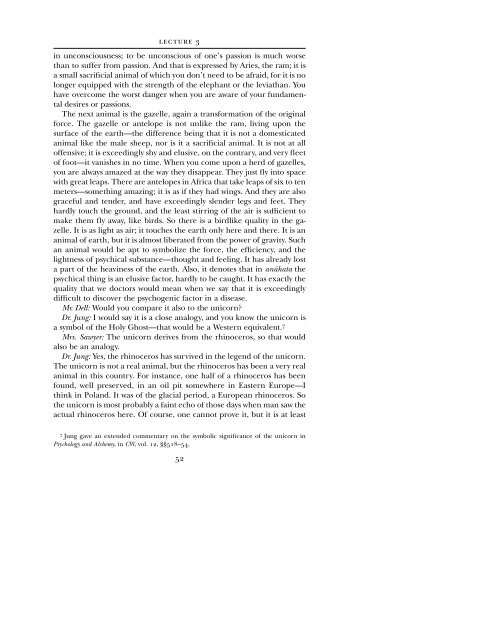CG JUNG - Countryside Anarchist
CG JUNG - Countryside Anarchist
CG JUNG - Countryside Anarchist
Create successful ePaper yourself
Turn your PDF publications into a flip-book with our unique Google optimized e-Paper software.
LECTURE 3<br />
in unconsciousness; to be unconscious of one’s passion is much worse<br />
than to suffer from passion. And that is expressed by Aries, the ram; it is<br />
a small sacrificial animal of which you don’t need to be afraid, for it is no<br />
longer equipped with the strength of the elephant or the leviathan. You<br />
have overcome the worst danger when you are aware of your fundamental<br />
desires or passions.<br />
The next animal is the gazelle, again a transformation of the original<br />
force. The gazelle or antelope is not unlike the ram, living upon the<br />
surface of the earth—the difference being that it is not a domesticated<br />
animal like the male sheep, nor is it a sacrificial animal. It is not at all<br />
offensive; it is exceedingly shy and elusive, on the contrary, and very fleet<br />
of foot—it vanishes in no time. When you come upon a herd of gazelles,<br />
you are always amazed at the way they disappear. They just fly into space<br />
with great leaps. There are antelopes in Africa that take leaps of six to ten<br />
meters—something amazing; it is as if they had wings. And they are also<br />
graceful and tender, and have exceedingly slender legs and feet. They<br />
hardly touch the ground, and the least stirring of the air is sufficient to<br />
make them fly away, like birds. So there is a birdlike quality in the gazelle.<br />
It is as light as air; it touches the earth only here and there. It is an<br />
animal of earth, but it is almost liberated from the power of gravity. Such<br />
an animal would be apt to symbolize the force, the efficiency, and the<br />
lightness of psychical substance—thought and feeling. It has already lost<br />
a part of the heaviness of the earth. Also, it denotes that in anvhata the<br />
psychical thing is an elusive factor, hardly to be caught. It has exactly the<br />
quality that we doctors would mean when we say that it is exceedingly<br />
difficult to discover the psychogenic factor in a disease.<br />
Mr. Dell: Would you compare it also to the unicorn?<br />
Dr. Jung: I would say it is a close analogy, and you know the unicorn is<br />
a symbol of the Holy Ghost—that would be a Western equivalent. 7<br />
Mrs. Sawyer: The unicorn derives from the rhinoceros, so that would<br />
also be an analogy.<br />
Dr. Jung: Yes, the rhinoceros has survived in the legend of the unicorn.<br />
The unicorn is not a real animal, but the rhinoceros has been a very real<br />
animal in this country. For instance, one half of a rhinoceros has been<br />
found, well preserved, in an oil pit somewhere in Eastern Europe—I<br />
think in Poland. It was of the glacial period, a European rhinoceros. So<br />
the unicorn is most probably a faint echo of those days when man saw the<br />
actual rhinoceros here. Of course, one cannot prove it, but it is at least<br />
7 Jung gave an extended commentary on the symbolic significance of the unicorn in<br />
Psychology and Alchemy, inCW, vol. 12, §§518–54.<br />
52


